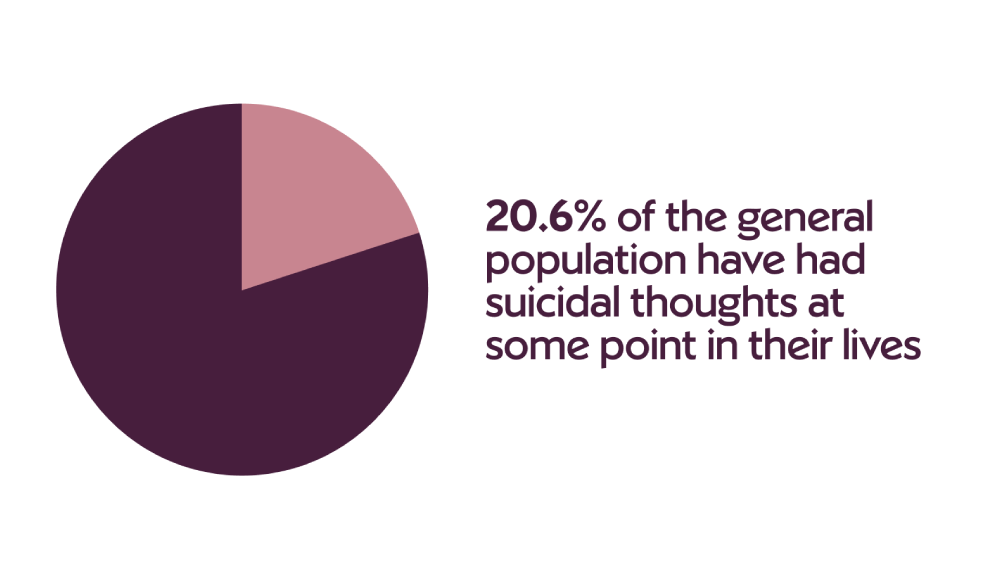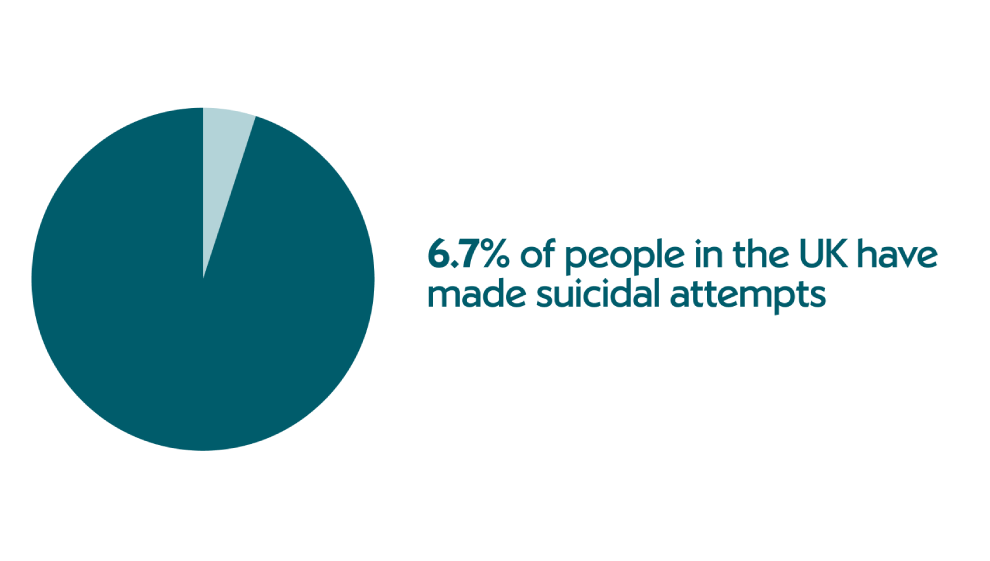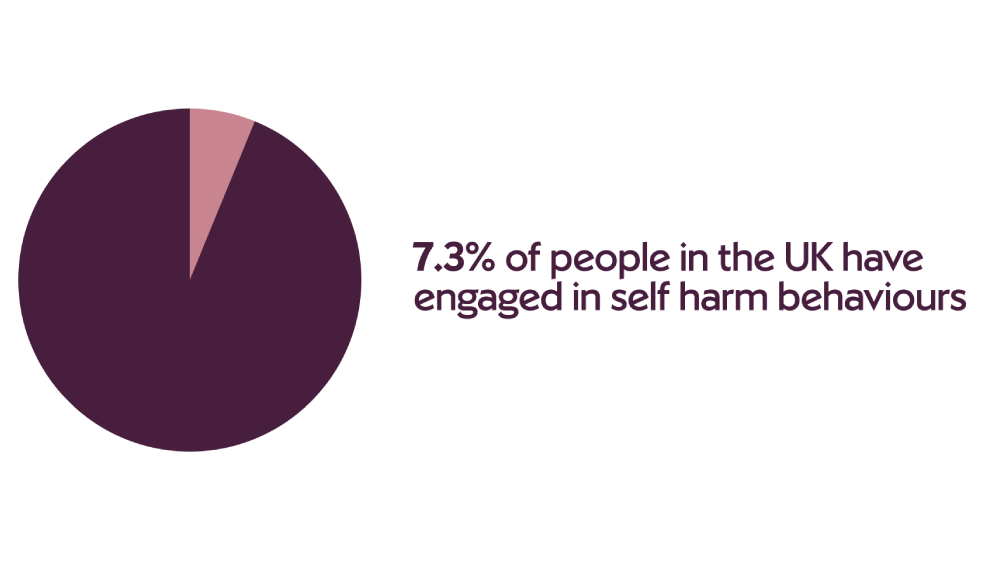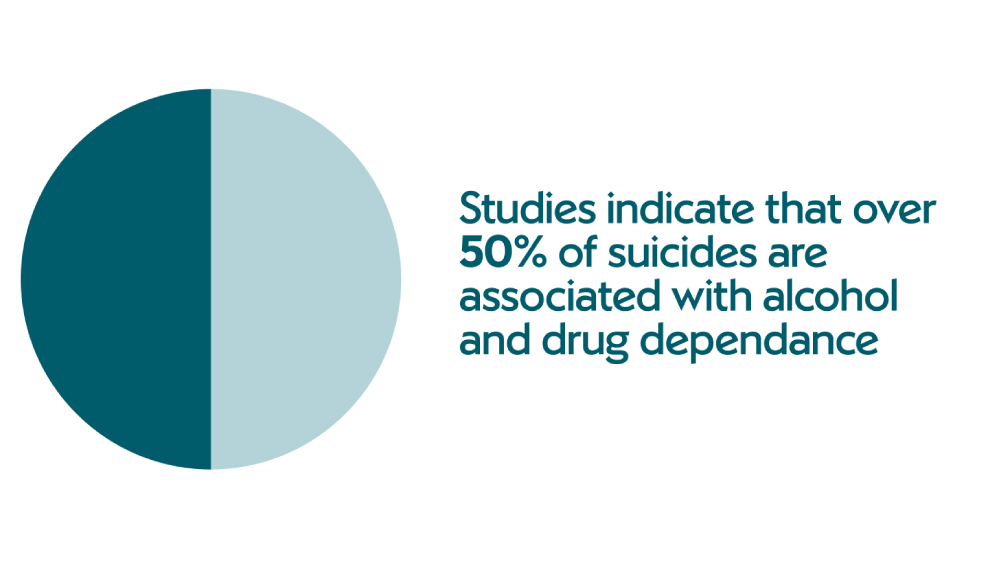Suicide prevention information and support
When to seek help
Information in this article may be triggering for some.
If you or someone you know is experiencing suicidal thoughts or ideations, seek help immediately using one of the helplines listed below:
- Samaritans: call 116 123 (free 24-hour helpline)
- You can also text 'SHOUT' to 85258 if struggling to cope.
- SANEline: call 0300 304 7000 (16:30 – 22:00 every day of the year)
- National Suicide Prevention Helpline UK: 0800 689 5652 (6 pm to midnight every day)
A full list of NHS emergency helplinesCrisis support can be obtained 24/7 by phoning 111. In the event of an emergency, please phone 999 or attend A&E for 24-hour emergency help with suicidal ideas if required.
Suicide at a glance

It can be very difficult for someone not experiencing depression or thoughts of suicide to understand what leads so many individuals to take their own lives. Every life lost to suicide has a deep effect on the families, friends, and community of the people left behind.
Raising standards of suicide awareness and education across all areas of society is of the upmost importance. Everything from how we talk to our loved ones about suicide to the language we use when we do it can have a profound impact on how we as a society understand and approach treatment for suicidal thoughts.
Those who have previously attempted suicide are at a higher risk of taking their own life in the future, which also makes it necessary for us all to improve care standards for individuals who have attempted suicide or self-harm in the past.
The facts and figures
- Over 800,000 people take their own life every year. That works out at roughly one person every 40 seconds
- The importance of support cannot be underestimated. A previous suicide attempt is the single most important risk factor for suicide mitigation
- Suicide is the leading cause of death in men under 50
- Suicide affects children as well as adults. In the UK, over 200 teenagers lose their lives to suicide every year
- A staggering 9% of employees in the UK are currently experiencing thoughts of self-harm or suicide
- The stigma and taboo around mental health conditions is thought to be a contributing factor to higher incidence rates of suicide
Why would an individual attempt suicide?
For the families and communities affected by suicide, trying to understand why an individual would take their own life can be difficult. If a close friend or family member dies by suicide, you may be left wondering if there was something you missed.

Whilst there is no single cause for suicide, depression is one of the most common causes of suicide. Other risk factors that may increase the likelihood of someone attempting suicide are:
- Substance abuse problems
- Bipolar disorder
- Schizophrenia
- Brain injury
- Chronic physical health problems
- Anxiety disorder
There are other factors that increase the likelihood of attempting suicide. These include easy access to ways to means, such as firearms. Ongoing stressful life events like chronic illness, divorce, loss of a child or financial crisis can also increase risk.
One of the strongest risk factors for some to take their own life is whether they have attempted suicide previously.
Are there signs that someone is suicidal?
There are some common signs associated with suicide, however it is important to understand that a number of these signs and symptoms crossover with other mental health problems.
Things to look out for in another person include:
- Changes at work (productivity, attentiveness, lateness/absences)
- Lethargy and increased fatigue
- Changes in social functioning (withdrawing from socialising)
- Personality changes or extreme mood swings
- A newfound anxiety or agitation
- Reckless behaviour and increased alcohol or drug use
- Changes in eating/sleeping pattern
- Talking or writing about wanting to self-harm or die
- Talking or writing about hopelessness, having nothing to live for, or being in unbearable pain
- Talking or writing about being a burden to others
- Reading about or searching online for ways to die by suicide
- Searching online for methods or seeking access to firearms, pills, or other means of suicide.
Self-harm and suicide

Self-harm describes a wide range of actions and activities an individual may undergo to cause deliberate damage or pain to themselves.
There is a relationship between self-harm and suicide, however most cases of self-harm are not an attempt at suicide. A person may self-harm because they do not feel in control, or because they want to punish themselves.
Also, attempts at suicide are far less common than incidents of self-harm. Self-harm is often engaged to manage uncomfortable feelings, whereas a suicide attempt is done with the intent to take one’s life. The most common methods of self-harm are cutting (70%), self-hitting (30%), and burning (28%).
Substance abuse and suicide

Feelings of hopelessness can enhance thoughts of suicide. The toxic effect produced when we ingest alcohol and certain drugs can amplify this feeling. The blood/alcohol concentration level of 63.5% of individuals who die by suicide indicated intoxication at the time of death.
The relationship between suicide and substance abuse problems like drug addiction and alcoholism cannot be overlooked. An estimated 25% of alcoholics and drug addicts die by suicide.
When compared with the general population, individuals suffering with alcohol dependence, or a drug use problem are 10 to 14 times more likely to die by suicide. Inside of these figures, it’s also thought that the severity (whether the individual is misusing more than one substance) may further increase an individuals likelihood of attempting suicide.
When and how to seek help
If you or someone you know is experiencing a crisis episode, act immediately.
Confidential advice and support for your mental health is available for free, 24 hours a day, from either the Samaritans (call 116 123 or text 'SHOUT' to 85258) or by phoning 111. Please phone 999 or attend your nearest A&E for 24-hour emergency help with suicidal ideas if required.
Last updated Tuesday 20 August 2024
First published on Friday 22 September 2023

